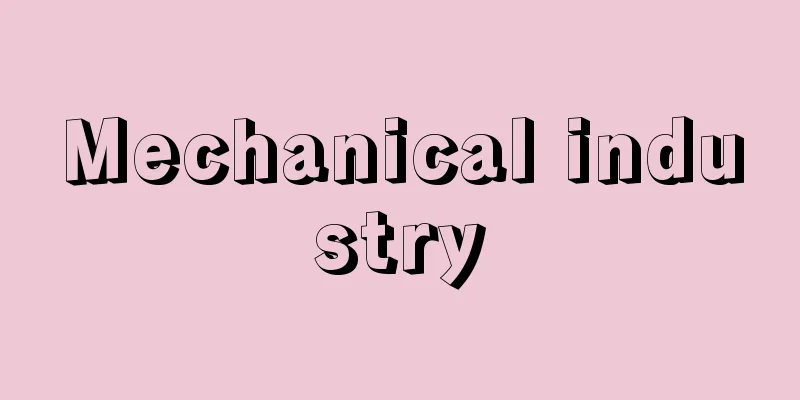Mechanical industry

|
An industry that produces all kinds of machinery, from consumer goods to production goods. The machinery industry includes general-purpose machinery and equipment manufacturing, such as general industrial machinery and equipment manufacturing, production machinery and equipment manufacturing, such as construction and mining machinery manufacturing, textile machinery manufacturing, metal processing machinery manufacturing, such as metal tool manufacturing and robot manufacturing, electronic parts, devices, and electronic integrated circuit manufacturing, electrical machinery and equipment manufacturing, information and communications machinery and equipment manufacturing, and transportation machinery and equipment manufacturing. In particular, the metal tool manufacturing, electrical machinery and equipment manufacturing, and transportation machinery and equipment manufacturing industries form the core of the machinery industry. The birth of the mechanical industry was linked to the Industrial Revolution, and together with the civil revolution, it provided an objective basis for the formation of a capitalist society. During the Industrial Revolution, the advancement of textile machinery was remarkable, but the establishment of the machine tool industry, which is the machine that makes machines, built the framework of the capitalist reproduction system. In addition, in the second half of the 19th century, there were changes such as the appearance of electrical machinery and the large-scale production of chemical machinery. In the 20th century, the automobile, a representative transportation machine, emerged. In addition, new sectors were developed one after another, and the development of the mechanical industry saw the expansion of production capacity, which marked the stage of the industrial complex called the industrial complex. When manufacturing transforms into large-scale mechanical industry, there are two routes: one in which many parts are combined to create a finished product, as in the case of electrical machinery and automobile production, and the other in which many production processes are composed of machines and devices that form a single mechanism, as in the case of the manufacturing process of chemical products. The former promotes the standardization of parts and develops into mechanical automation, while the latter develops into process automation. [Katsuaki Onishi September 17, 2019] Japanese Machinery IndustryIn Japan, domestic production of British-style lathes began in 1889 (Meiji 22), but the majority of machinery in the Meiji period was imported. Moreover, the main driver of the machinery industry was the government-run military arsenal. Until World War II, Japan's machinery industry was dependent on foreign technology and specialized in military production under government leadership. Nevertheless, the textile machinery manufacturing industry and the zaibatsu-affiliated shipbuilding industry made remarkable progress, and some companies even achieved independent development of machine tools. In 1939 (Showa 14), the machinery industry surpassed the spinning industry in terms of production value, and in 1942, there were 24,910 machinery manufacturing establishments with five or more employees, with approximately 2.06 million employees and a production value of approximately 53.3 billion yen. During the recovery process after World War II, there was a surge in the export light machinery industry, including watches, sewing machines, and cameras. The export light machinery industry earned foreign currency and contributed to the later shift of Japanese industry to heavy chemical industry. During the period of rapid economic growth, the machinery industry expanded unprecedentedly, initially relying on technology imported from overseas, and accompanied by rapid expansion of companies into new sectors such as electronics, passenger cars, and chemical machinery. High economic growth and the development of heavy and chemical industries were driven by a mutual interdependence that saw investment in the steel and four machinery sectors attracting further investment. From the late 1950s, an advanced mass production system was established, and household appliances such as televisions, refrigerators, and washing machines became widespread, and passenger car production began in earnest. In 1962, Nissan's Oppama plant established a mass production system by organically combining modern transfer machines (machine tools that continuously process materials using conveyer belts) with a large number of subcontracted parts manufacturers. Inspired by automobiles and household appliances, the machine tool department also expanded. Thereafter, production of color televisions, air conditioners, computers, aircraft, chemical machinery, and other products increased. The country fell into a recession in 1965, but driven by special demand for the Vietnam War and public investment, huge capital investment was made with the aim of strengthening international competitiveness under an open economic system, leading to the construction of huge industrial complexes for automobiles, electrical products, chemical products, and steel, and the movement toward automation that incorporates computers. The machinery industry was severely affected by the stagnation of large-scale capital investment in the low-growth economy following the dollar shock of 1971 and the oil shock of 1973. However, by sharpening the Japanese production system and building a structure capable of efficiently producing high-performance products, Japan's machinery industry, particularly the transportation machinery and equipment manufacturing industry and the electrical machinery and equipment manufacturing industry, expanded exports. The oil shock also gave an advantage to Japanese automobile manufacturers, who focused on small car production, and exports of automobiles and electrical products came to support the sluggish Japanese economy. In the 1970s, the metalworking machine manufacturing industry promoted the incorporation of computers into machines, based on the miniaturization, high performance, and low cost of computers. This trend coincided with the industrial trend of rationalization and labor saving during the recession, and led to market expansion. The production value of NC (numerical control) machine tools, machining centers (computer-controlled multi-tasking machine tools), etc. accounted for more than half of the production value of machine tools. In the 1980s, the mass production of automobiles and electrical products further promoted the development of industrial robots and unmanned operations. In the metalworking machine manufacturing industry, etc., the aforementioned NC machine tools and machining centers were integrated to create revolutionary production systems known as FMS (flexible manufacturing systems) and FA (factory automation). Not only exports, but also foreign direct investment in the machinery industry has expanded, and internationalization is progressing. Since then, foreign demand has accounted for nearly half of the metalworking machine market. In the 1990s, the Internet began to be used in industry, leading to closer collaboration between machines and devices, across entire companies, and between companies on a global scale. According to the Industrial Statistics Table, the number of machinery manufacturing establishments with four or more employees decreased from 2014 to 2016, while the number of employees remained the same, shipment value increased, and productivity improved, showing basic trends. Specifically, the shipment value of the general-purpose machinery and equipment manufacturing industry increased from 10,103,055 million yen (2014) to 11,124,756 million yen (2016), and the number of employees increased from 308,841 to 319,153, but the number of establishments decreased from 7,141 to 6,767. The shipment value of the general industrial machinery and equipment manufacturing industry increased from 3,206,058 million yen (2014) to 3,731,498 million yen (2016), and the number of employees increased from 92,613 to 99,916, but the number of establishments decreased from 2,215 to 2,188. Similarly, the shipment value of the production machinery and equipment manufacturing industry increased from 16,590,604 million yen (2014) to 18,106,818 million yen (2016), and the number of employees increased from 550,642 to 587,805, but the number of establishments decreased from 19,083 to 18,535. The shipment value of the metal processing machinery manufacturing industry increased from 4,265,901 million yen (2014) to 4,321,742 million yen (2016), and the number of employees increased from 155,772 to 159,852, but the number of establishments decreased from 5,907 to 5,654. The shipment value of the metalworking machine manufacturing industry has decreased from 1,921,286 million yen (2014) to 1,750,163 million yen (2016), the number of employees from 48,795 to 48,175, and the number of establishments from 616 to 600, all of which are decreasing. The shipment value of the industrial robot manufacturing industry has increased from 495,399 million yen (2014) to 850,448 million yen (2016), and the number of employees from 14,416 to 18,671, showing an upward trend, but the number of establishments has decreased from 423 to 402. The shipment value of the electrical machinery and equipment manufacturing industry has decreased from 17,031,700 million yen (2014) to 16,388,349 million yen (2016), showing a downward trend. The number of employees has decreased from 481,936 to 477,529, and the number of business establishments from 8,953 to 8,507. The shipment value of the transportation machinery and equipment manufacturing industry has increased from 60,063,334 million yen (2014) to 64,991,236 million yen (2016), and the number of employees has increased from 980,505 to 1,057,212, but the number of business establishments has decreased from 10,415 to 9,991. Statistics from the Japan Machine Tool Builders' Association also show that the shipment value has continued to increase since 2016, and exports have also increased. However, in 2018 and 2019, due to the impact of the US-China trade friction and the issue of the UK's withdrawal from the EU, business performance is likely to remain sluggish. [Katsuaki Onishi September 17, 2019] Global trends after the Fourth Industrial RevolutionOn the other hand, the Fourth Industrial Revolution, the modernization of manufacturing and machinery industries on an international scale unlike anything seen before, is progressing. In 2010, the German government proposed 11 "future projects" as the "High Tech Strategy 2020". In 2011, the industrial technology exhibition "Hannover Messe 2011" set the direction of digitalization of production systems and the pursuit of "Industry 4.0" which will lead to the Fourth Industrial Revolution as the agenda for related action plans. Since then, at the 46th Annual Meeting of the World Economic Forum (2016) and other events, AI (artificial intelligence), IoT (Internet of Things), and robotics technology transformation have been targeted as the Fourth Industrial Revolution aiming for unmanned factories. Meanwhile, the United States has been promoting the modernization of its mechanical engineering industry by incorporating 3D printers and AI. The country has developed and put into practical use 3D printers that manufacture parts and products by an efficient method of layering materials such as resin and metal. In addition, the United States is establishing a dominant position in areas such as big data and cloud computing. China also announced "Made in China 2025" in 2015, with the goal of transforming the country into a global manufacturing powerhouse by 2025 and joining the leading group of global manufacturing powers by 2049, the 100th anniversary of the founding of the People's Republic of China, with the aim of implementing focused development measures in 10 industries, including next-generation information technology, machine tools, and automobiles that utilize new energy sources. In the 21st century, the machinery industry is undergoing a transformation on a global scale with the advancement of digitalization, softwareization, and service-oriented approaches. Advances are being made in the development of machines and equipment themselves, advanced use of AI and industrial robots, utilization of IoT and cloud computing, and systemization, and in this process, collaboration between humans and machines, between companies and industries, and the international division of labor are undergoing major changes. China's rapid growth in particular demonstrates the diverse potential of emerging countries. The existing order and international division of labor are being reorganized, and the development of electric vehicles is leading to the fusion of the automobile industry and the electrical machinery and equipment manufacturing industry. In Japan, smart factories and "Society 5.0" (a human-centered society that balances economic development and the resolution of social issues through a system that highly integrates cyberspace (virtual space) and physical space (real space)) are being proposed. However, Japan's machinery industry is not leading the way in new fields as it was in the 1980s. Nevertheless, the integration of industrial machinery with the next-generation 5G high-speed and large-capacity communication standard, data collected from sensors in factories, analysis of information, thorough prediction of machine failures through learning, further automation of manufacturing processes, remote-controlled automatic control systems, and overall optimization of production are becoming concrete. [Katsuaki Onishi September 17, 2019] [References] | |Source: Shogakukan Encyclopedia Nipponica About Encyclopedia Nipponica Information | Legend |
|
消費財から生産財に至るあらゆる機械を生産する工業。機械工業の範囲は、一般産業用機械・装置製造業などの汎用(はんよう)機械器具製造業、建設機械・鉱山機械製造業、繊維機械製造業などの生産用機械器具製造業、金属工作機械製造業、ロボット製造業などの金属加工機械製造業、電子部品・デバイス・電子集積回路製造業、電気機械器具製造業、情報通信機械器具製造業、輸送用機械器具製造業などに及ぶ。とくに、金属工作機械製造業、電気機械器具製造業、輸送用機械器具製造業が、機械工業の主軸を担っている。 機械工業の誕生は、産業革命と連動しており、市民革命ともども、資本主義社会の形成に客観的基盤を与えた。産業革命期には繊維機械の躍進が顕著であったが、機械をつくる機械である工作機械工業の確立により、資本主義的な再生産体系の骨格が構築されてきた。加えて、19世紀後半には、電気機械の登場、化学機械の大規模化といった変革があった。20世紀に入って、代表的な輸送用機械である自動車が台頭してくる。また次々に新しい部門が開拓され、機械工業の発達により、コンビナートという段階を画する生産力の拡充がみられた。マニュファクチュアが機械制大工業に転化する際には、電気機械、自動車生産のように、多くの部品を組み合わせ一つの完成品をつくりあげる経路と、化学製品の製造工程のように、多くの生産工程が一つの機構をなす機械・装置によって構成される経路とがある。前者は部品の規格化を進め、メカニカル・オートメーションに、後者はプロセス・オートメーションへと展開することになる。 [大西勝明 2019年9月17日] 日本の機械工業日本では、1889年(明治22)に、イギリス式旋盤の国産化が開始されるが、明治期の機械の過半は、輸入に依存していた。しかも、機械工業の主たる担い手は、官営軍工廠(ぐんこうしょう)であった。第二次世界大戦時までの日本の機械工業は、技術を外国に依存しながら、政府主導のもとで軍事生産に特化した経緯をたどっている。それでも、繊維機械製造業や財閥系の造船業などは顕著な発達を遂げ、また、一部で工作機械の自主開発が実現している。機械工業は1939年(昭和14)には紡績業の生産額を上回り、1942年の従業者5人以上の機械製造事業所は2万4910か所、従業者数約206万人、生産額は約533億円に達していた。第二次世界大戦後の復興過程においては時計、ミシン、カメラなど輸出軽機械工業の躍進があった。輸出軽機械工業は外貨を獲得し、後の日本産業の重化学工業化に寄与している。 高度経済成長期、当初は海外からの導入技術に依存し、エレクトロニクス製品、乗用車、化学機械など新部門への急速な企業進出を伴いつつ、機械工業は、類例のない拡張をみせた。鉄鋼と機械4部門への投資が投資をよぶとされた相互依存関係を軸に、高度経済成長、重化学工業化が推進されている。 1950年代後半からは、高度な大量生産体制の形成があり、テレビ、冷蔵庫、洗濯機に代表される家電製品の普及と乗用車生産が本格化した。1962年(昭和37)に日産の追浜(おっぱま)工場では、近代的なトランスファーマシン(ベルトコンベヤーで加工を連続的に処理する工作機械設備)と多数の下請部品メーカーとを有機的に結合したうえでの量産体制が確立された。自動車、家電に触発され、工作機械部門も拡充している。その後、カラーテレビ、クーラー、コンピュータ、航空機、化学機械等の生産が増大している。1965年には不況に陥るが、ベトナム戦争特需や公共投資に牽引(けんいん)され、開放経済体制下で国際競争力の強化を意図した巨額な設備投資が遂行されて、自動車、電気製品、化学製品、鉄鋼関連の巨大なコンビナートの建設や、コンピュータを包摂したオートメーション化の動きが進展することになる。1971年のドル・ショック、1973年のオイル・ショック後の低成長経済下で大型設備投資の停滞があり、機械工業は深刻な影響を受けた。しかし、日本的生産システムを先鋭化して高性能な製品を効率よく生産しうる体制の構築を通して、日本の機械工業、なかでも輸送用機械器具製造業、電気機械器具製造業は、輸出拡大を進めてきた。そして、オイル・ショックは、小型車生産に重点を置いた日本の自動車メーカーを有利にし、不振の日本経済を自動車、電気製品の輸出が支えることになる。 また、1970年代には、金属工作機械製造業が、コンピュータの小型化・高性能化・低価格化を基盤に、機械によるコンピュータの内蔵化を進めている。この潮流は、不況下で合理化・省力化を志向する産業動向と合致し、市場拡大をもたらした。NC(numerical control=数値制御)工作機械、マシニングセンター(コンピュータ制御による複合加工工作機械)等の生産額が、工作機械の生産額の過半を占めている。1980年代には自動車、電気製品の量産化は、産業用ロボットの開発や無人化をいっそう進めることになる。そして、金属工作機械製造業等では、先のNC工作機、マシニングセンター等と一体化してFMS(フレキシブル生産システム)、FA(ファクトリー・オートメーション)とされる画期的な生産システムを誕生させている。輸出のみでなく、機械工業の対外直接投資の拡大があり、国際化が進展している。また、その後にわたり、外需が金属工作機械市場の半数近くを占めている。1990年代には、インターネットの産業界での活用が始まり、機械・装置間の連携、企業全体、企業間連携がグローバルで緊密なものになる。 工業統計表によれば、2014年(平成26)から2016年までの4人以上の機械工業の事業所数は減少、従業者数は現状維持、出荷額は増大、生産性向上という基本的傾向を示している。具体的に、汎用機械器具製造業の出荷額は10兆1030億5500万円(2014)から11兆1247億5600万円(2016)へ、従業者数は30万8841人から31万9153人に増大しているが、事業所数は7141から6767に減少している。一般産業用機械・装置製造業の出荷額は、3兆2060億5800万円(2014)から3兆7314億9800万円(2016)、従業者数は9万2613人から9万9916人へと増えているが、事業所数は2215から2188に減少している。同じく、生産用機械器具製造業の出荷額は16兆5906億0400万円(2014)から18兆1068億1800万円(2016)、従業者数は55万0642人から58万7805人へと増加しているが、事業所数は1万9083から1万8535に減少している。金属加工機械製造業の出荷額は4兆2659億0100万円(2014)から4兆3217億4200万円(2016)へ、従業者数も15万5772人から15万9852人に増加しているが、事業所数は5907から5654に減少している。金属工作機械製造業の出荷額は1兆9212億8600万円(2014)から1兆7501億6300万円(2016)、従業者数は4万8795人から4万8175人、事業所数は616から600で、いずれも減少している。産業用ロボット製造業の出荷額は4953億9900万円(2014)から8504億4800万円(2016)、従業者数は1万4416人から1万8671人で増加傾向にあるが、事業所数は423から402で減少気味である。電気機械器具製造業の出荷額は17兆0317億0000万円(2014)から16兆3883億4900万円(2016)と減少傾向にある。従業者数は48万1936人から47万7529人、事業所数は8953から8507へと減少している。輸送用機械器具製造業の出荷額は60兆0633億3400万円(2014)から64兆9912億3600万円(2016)へ、従業者数は98万0505人から105万7212人へと増加しているが、事業所数は1万0415から9991へと減少している。日本工作機械工業会の統計でも、出荷額は2016年以降増大を続け、輸出も増加している。しかし、2018年、2019年には、米中貿易摩擦、イギリスのEU離脱問題等に影響を受け、業績は、低迷傾向をたどりそうである。 [大西勝明 2019年9月17日] 第四次産業革命以降の世界の動向他方、第四次産業革命、従来と異なる国際的規模での製造業、機械工業の現代化が進展している。ドイツ政府は、2010年に「ハイテク戦略2020」として11の「未来プロジェクト」を提案した。2011年、産業技術の展示会「ハノーバーメッセ2011」で関連するアクションプランとして生産システムのデジタル化の指向、第四次産業革命につながる「インダストリー4.0」の追究を課題とすることになる。その後、2016年以降、第46回世界経済フォーラム(2016)の年次総会等において、無人化工場を指向する第四次産業革命としてAI(人工知能)やIoT(モノのインターネット)、ロボット技術の変革がターゲットにされている。 一方、アメリカは、3Dプリンター、AIを取り入れた機械工業の現代化を推進してきた。樹脂、金属等素材を積層という効率的な方式で部品、製品を製作する3Dプリンターを開発、実用化している。加えて、ビッグデータやクラウドコンピューティングといった分野で支配的地位を築きつつある。 中国でも、2015年に「中国製造2025」を発表し、2025年までに世界の製造強国に転成し、建国100周年となる2049年までに世界の製造強国の先頭グループへの参画を目標に次世代情報技術や工作機械、新エネルギーを活用した自動車など10業種の重点育成策を展開しようとしている。 21世紀、機械工業は、デジタル化、ソフト化、サービス化を進め、世界的な規模で変革を遂げつつある。機械・装置そのものの発展、AI、産業用ロボットの高度利用、IoT・クラウドの活用、システム化等が進められ、この過程において人間と機械、企業間、産業間の連携、国際分業が大きく変化している。とくに中国の躍進は、新興国の多様な可能性を示している。既存の秩序や国際分業は改編されつつあり、電気自動車の開発は、自動車工業と電気機械器具製造業との融合を招いている。 そして、日本でも、スマート工場や、「ソサエティー5.0」(サイバー空間〈仮想空間〉とフィジカル空間〈現実空間〉を高度に融合させたシステムにより、経済発展と社会的課題の解決を両立する、人間中心の社会)が提唱されている。だが、日本の機械工業は、新しい分野で1980年代のように主導的ではない。それでも、高速で大容量の次世代通信機規格5Gと産業機械との融合、工場内のセンサーから収集したデータ、情報の分析、学習を通しての機械の故障予知の徹底、製造工程のいっそうの無人化、遠隔操作による自動制御システムや生産の全体的な最適化が具体化しつつある。 [大西勝明 2019年9月17日] [参照項目] | |出典 小学館 日本大百科全書(ニッポニカ)日本大百科全書(ニッポニカ)について 情報 | 凡例 |
<<: Steel for machine structure
>>: Occasionalism - Occasionalism
Recommend
Anguloa
...(2) Tropical America: South of Mexico and Flor...
Oishi Ruins - Oishii Seki
A site from the final Jomon period in Oishi, Ogata...
Kimberley Central Mining Company
...At the end of 1971, there were about 3,600 lea...
Respiratory function test
Respiratory function is sufficient if it is able t...
Ekistics (English spelling)
…He went into exile for a time, and after returni...
Cosmic Presence - Uchuu Sonzaido
...Chemical analysis of Earth's materials is ...
Gelsenkirchen (English spelling)
A mining and industrial city in North Rhine-Westp...
Phonological opposition
…He was one of the central figures of the Prague ...
Canary Smelly - Quite a smelly smell
→Canary Glass Source: Shogakukan Encyclopedia Nip...
Kolbenheyer - Erwin Guido Kolbenheyer
1878‐1962 German author. Born in Budapest, he was ...
Trautwein, F. (English spelling) TrautweinF
...Various timbres are created by using a sound s...
Cooperative Agricultural Extension Service Grants - Kyodo nougyou fukyoujigyo koufukin
...(1) Rapid dissemination of advanced and compre...
Avon Products, Inc.
The world's largest American cosmetics manufac...
Covalent bond theory
...By examining the elemental composition of vari...
Kyomai - Kyoto dance
A type of Kamigatamai (Kamigata Dance) , a Japanes...









